
-
Trova l'alimento giustoFai questo quiz per scoprire quale alimento potrebbe essere più adatto al tuo amico peloso.Trova l'alimento giustoFai questo quiz per scoprire quale alimento potrebbe essere più adatto al tuo amico peloso.Prodotti Correlati
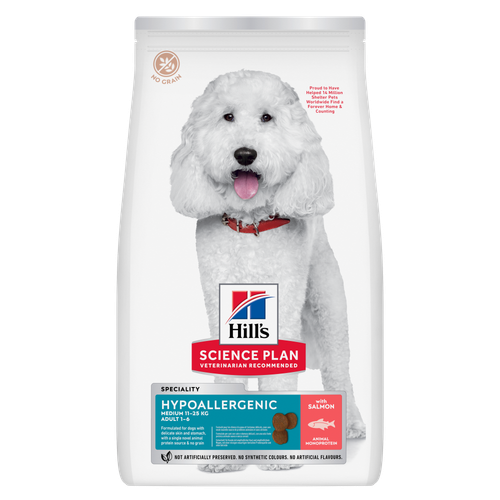 Hypoallergenic Adult Medium alimento per cani
Hypoallergenic Adult Medium alimento per caniHill's Science Plan Hypoallergenic Adult Medium alimento secco per cani al Salmone è un alimento completo per cani adulti di taglia media da 1 a 6 anni. È formulato per cani con cute e stomaco delicati, con limitate proteine nuove di alta qualità e senza cereali.
Acquista ora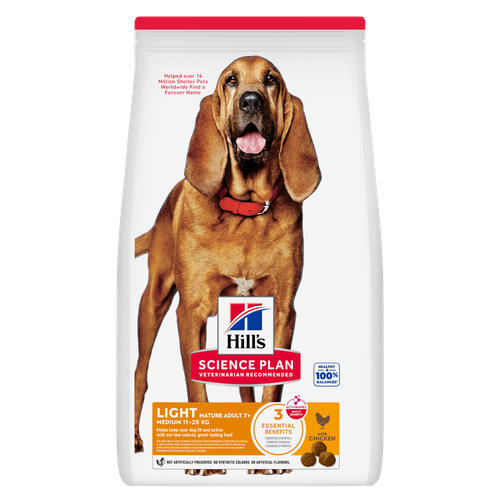 Light Medium Mature Adult alimento per cani
Light Medium Mature Adult alimento per caniHill’s Science Plan Light Mature Adult Medium alimento per cani con pollo è un alimento completo per cani, appositamente formulato con la tecnologia ActivBiome+ Multi-Benefit.
Aiuta il tuo cane a mantenersi in forma e attivo con il nostro gustoso alimento a ridotto contenuto calorico.
Un’alimentazione precisa per i cani adulti maturi meno attivi, che necessitano di un alimento a ridotto contenuto calorico per mantenere un peso e uno stile di vita sani.Acquista ora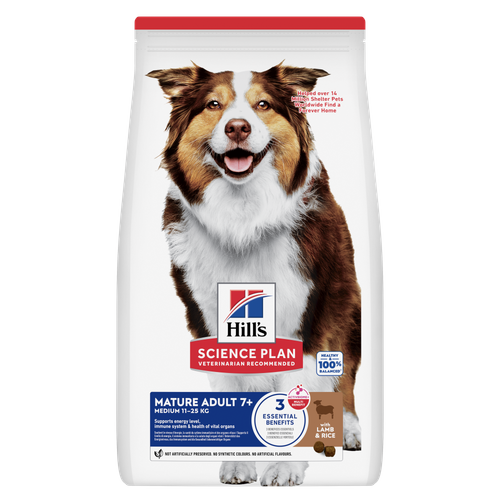 Medium Mature Adult alimento per cani
Medium Mature Adult alimento per caniHill’s Science Plan Mature Adult Medium Breed alimento per cani con agnello e riso è un alimento completo per cani, appositamente formulato con la tecnologia ActivBiome+ Multi-Benefit.
Questo alimento è stato studiato appositamente per le esigenze dei cani di taglia media durante l'invecchiamento.Acquista oraBisogni SpecificiProdotti Correlati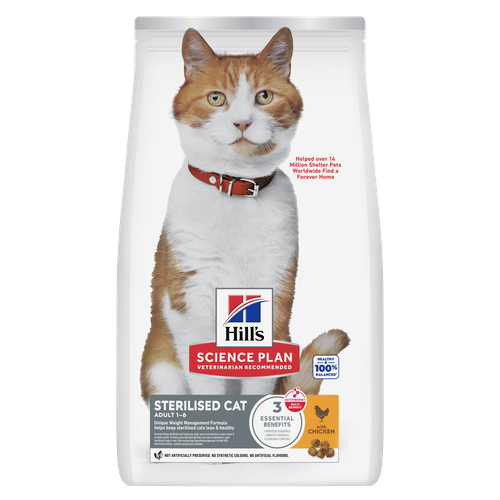 Sterilised Cat Adult alimento per gatti
Sterilised Cat Adult alimento per gattiHill’s Science Plan Sterilised Cat Adult alimento secco per gatti con pollo è appositamente formulato con la tecnologia ActivBiome+ Multi-Benefit. Si tratta di un alimento bilanciato con precisione, studiato per soddisfare le esigenze dei gatti sterilizzati, per aiutarli a mantenersi snelli e in salute.
Acquista ora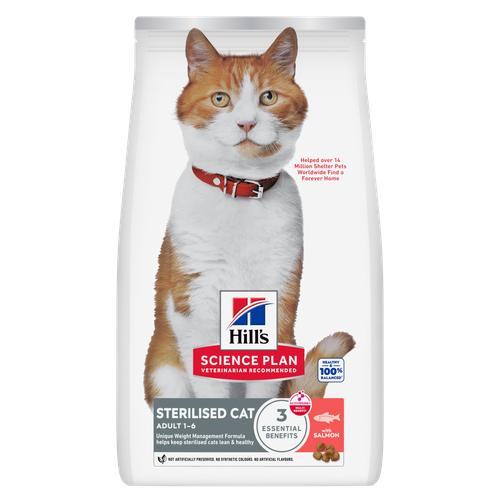 Sterilised Adult alimento per gatti
Sterilised Adult alimento per gattiHill’s Science Plan Sterilised Cat Adult alimento secco per gatti con salmone è appositamente formulato con la tecnologia ActivBiome+ Multi-Benefit. Si tratta di un alimento bilanciato con precisione, studiato per soddisfare le esigenze dei gatti sterilizzati, per aiutarli a mantenersi snelli e in salute.
Acquista ora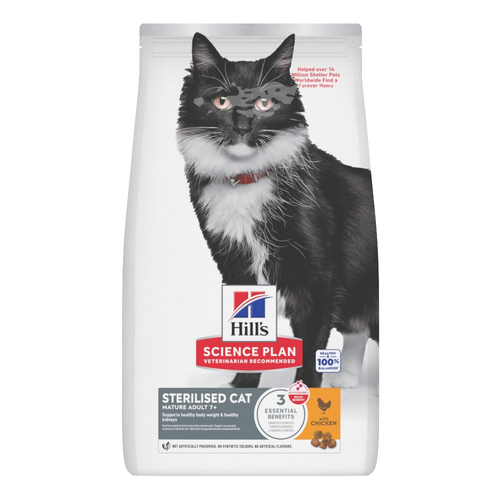 Sterilised Mature Adult alimento per gatti
Sterilised Mature Adult alimento per gattiHill’s Science Plan Sterilised Cat Mature Adult alimento per gatti con pollo è appositamente formulato con la tecnologia ActivBiome+ Multi-Benefit. Si tratta di una nutrizione accuratamente bilanciata, studiata per soddisfare le esigenze dei gatti adulti sterilizzati di età superiore ai 7 anni e per favorire un invecchiamento sereno.
Acquista ora -
Per Cani
- Articoli e consigli
-
Bisogni Specifici - Cani
- Peso
- Sensibilità Cutanee e Alimentari
- Vie Urinarie
- Digestione
- Articolazioni
- Reni
-
Età - Cani
- Nutrizione per Cuccioli
- Nutrizione per Adulti (1-6)
- Nutrizione per Adulti (7+)
Per Gatti- Articoli e consigli
-
Bisogni Specifici - Gatti
- Peso
- Sensibilità Cutanee e Alimentari
- Vie Urinarie
- Digestione
- Reni
-
Età - Gatti
- Nutrizione per Gattini
- Nutrizione per Adulti (1-6)
- Nutrizione per Adulti (7+)
Articoli correlati Le proteine
Le proteinePer la sintesi delle proteine, gli aminoacidi si legano insieme in una lunga catena.
Leggi di più I minerali
I mineraliSi ritiene che per i mammiferi siano indispensabili più di 18 elementi minerali.
Leggi di più Che cosa fanno gli alimenti umani al tuo animale: gli equivalenti calorici umani
Che cosa fanno gli alimenti umani al tuo animale: gli equivalenti calorici umaniScopri che effetto ha dare al tuo animale gli avanzi della tavola sulla quantità di calorie che assume quotidianamente grazie a questa semplice tabella con le equivalenze per gli esseri umani.
Leggi di più -
A proposito di Hill's

 Nutrizione basata sulla scienza che crea differenze di cui ti puoi fidare
Nutrizione basata sulla scienza che crea differenze di cui ti puoi fidare


Allergies aren't fun for anyone, but especially not for your dog, who can't tell you what's wrong. Food allergies and food intolerances can be a real pain for you and your dog, and they can be tricky to get to the bottom of. An abnormal response to a certain ingredient in food is usually referred to by vets as an ‘adverse food reaction’, or AFR. There are two main types of adverse food reactions: allergies, where the immune system is involved, and food intolerances, which occur without an immune component. Allergies tend to occur in reaction to protein components of the food, such as beef or chicken.
What causes adverse food reactions such as allergies?
The most common causes of food allergies/intolerance in dogs are protein sources, such as beef, chicken, dairy products and wheat. It may take months or years before your dog develops an allergic response to a particular food. However, once this has happened, there will almost always be an ongoing negative reaction to that food.
Adverse food reactions (AFRs) can occur at any age and usually last a lifetime. Some dog breeds appear more likely to develop AFRs, including West Highland white terriers, cocker spaniels and Irish setters.
You don’t need to get hung up on exactly what type of AFR your dog has, since the process for diagnosis and treatment are the same.
What are the signs of food allergies and intolerances in dogs?
The most common signs of an AFR are digestive upsets, skin irritation, or a combination of the two. Skin lesions on dogs with AFRs are frequently located on the face, feet, groin and ears.
Food allergies often mimic other skin diseases, and many dogs have other allergies, such as flea-bite sensitivity and atopy, at the same time. Atopy is an allergy to things in the environment such as pollen, dust mites and grasses. Dogs with chronic or recurring external ear inflammation and infections should also be evaluated for food allergies.
If your dog has an adverse food reaction, you may notice some or all of the following signs:
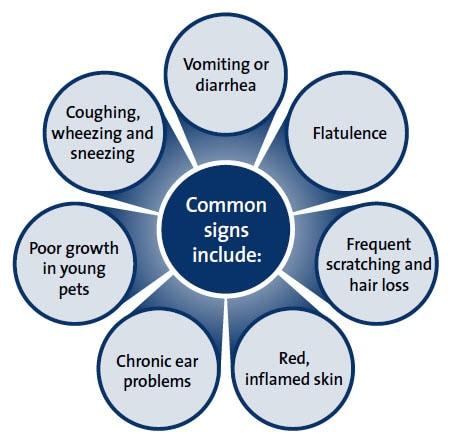
Vomiting or diarrhoea
Poor coat condition
Flatulence
Frequent scratching or hair loss
Red, inflamed skin
Chronic ear problems
Poor growth in young dogs
IMPORTANT: Some signs of AFRs are similar to those of other serious conditions, so consult your veterinarian if you notice any of these signs.


Deliziosi consigli
Durante il primo anno di vita, i cuccioli potrebbero aver bisogno di diverse visite per effettuare le vaccinazioni. Per i cani adulti generalmente è buona abitudine effettuare controlli annuali, mentre i cani anziani o con esigenze particolari potrebbero richiedere visite più frequenti.
How are food allergies diagnosed and treated?
The way your vet will approach diagnosing your dog’s AFR will depend on the clinical signs. Because both skin and gastrointestinal signs can mimic lots of other diseases, your vet may need to do skin scrapes and swabs and skin allergy testing. Ruling other things out is as important as ruling food allergy or intolerance in. With skin symptoms particularly, this can be a lengthy process, so be patient with your vet.
The main goal in diagnosing and managing food allergies or intolerances is to find and avoid the food ingredient responsible. The most practical and accurate method is a food elimination trial. There are two common approaches to this:
Hydrolysed diets. These are diets in which the protein source has been hydrolysed. This means that it has been broken into tiny parts that are too small for the body’s immune system to recognise as proteins. The carbohydrate sources will usually have been purified to take out the protein components and just leave the carbohydrate.
Novel protein diet. These diets are, as they sound, aimed at feeding your dog a protein that they have never been exposed to before, such as venison or duck.
Hydrolysed diets tend to be preferred for two main reasons. Firstly, in theory, you can feed these foods to any dog with any food allergy. Secondly, many people do not know exactly what proteins their dog has been exposed to, so finding a novel one may be a little uncertain.
Doing a food elimination trial
Transition to the new food. Your vet will ask you to gradually change your dog’s food over 5-7 days. You can do this by replacing a ⅕ of your dog’s old food the first day and then increasing the proportion of new food each day until they are eating only that food.
Cut out ALL extras. It’s essential during the trial that your dog only eats the therapeutic diet your vet has recommended. Treats, extras and chews should all be removed. Your vet may be able to recommend hypoallergenic treats or give you a recipe to make baked treats at home from the special diet.
Stay the course! It’s very important that you follow your vet’s instructions for how long the trial needs to be. For gut symptoms like vomiting and diarrhoea, this may only be 3-4 weeks, but for skin symptoms, you will need to stick with it for around 12 weeks to give the skin cycle time to show improvement.
Never try to simply remove ingredients from your dog's diet because you could easily end up malnourishing them.
What next?
When you get to the end of the elimination trial, you should have your answer as to whether your dog has an AFR or not. If not, then your vet will continue their work-up. If your dog is miraculously better, then you can both breathe a sigh of relief! What you do next depends on whether you want to know exactly what your dog is reacting to. If so, you can challenge your dog by adding a single protein source to the therapeutic diet for a couple of weeks. For example, add some cooked chicken breast every day and see what happens, then try beef or wheat, etc.
Many pet parents are so relieved that their dog feels better that they choose to simply stay on the special food. It keeps things simple!
While food allergies can be tricky to diagnose and cause a real headache (or tummy ache) for you and your dog, once they have been diagnosed, most dogs can go on to have normal lives by simply avoiding the offending food.
If your dog doesn’t respond to a food elimination trial, your vet may continue the process of ruling other skin and allergy issues in or out. This can take a while, so be patient and work with your vet to get to the bottom of things. Of course, your dog may have more than one type of allergy and may respond partially to a food trial but need more care for a different issue.
FAQs
What are the first signs of food allergies in dogs?
Some dogs get itchy skin and ears, while others have gastrointestinal symptoms like vomiting and diarrhoea – and some unlucky individuals get both!How do vets diagnose food allergies and intolerances?
Ultimately by doing a food elimination trial. Your vet may do other tests as well to rule out other diseases, depending on your dog’s symptoms.What’s the best diet for dogs with food allergies?
This will depend on what your dog is allergic to. Hydrolysed diets can be fed to any dog with an adverse food reaction. Your vet will advise you about your individual dog.How long does it take to see an improvement on a hypoallergenic diet?
Gastrointestinal symptoms usually resolve in 3-4 weeks, sometimes sooner. Skin symptoms can take up to 12 weeks, as the skin is much slower than the gut to heal and recover.Can you blood test for food allergies?
While there are blood tests available for food allergies, these are not currently reliable and are best avoided.
Reviewed by Dr. Hein Meyer, DVM, PhD, Dipl-ECVIM-CA and Dr. Emma Milne BVSc FRCVS.


Uno dei nostri autori ha preparato questo articolo per te
Prodotti Correlati

Hill’s Science Plan Mature Adult Medium Breed alimento per cani con agnello e riso è un alimento completo per cani, appositamente formulato con la tecnologia ActivBiome+ Multi-Benefit.
Questo alimento è stato studiato appositamente per le esigenze dei cani di taglia media durante l'invecchiamento.
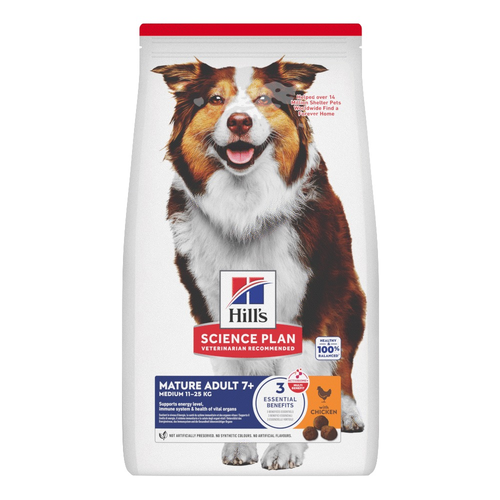
Hill’s Science Plan Mature Adult Medium Breed alimento per cani con pollo è un alimento completo per cani, appositamente formulato con la tecnologia ActivBiome+ Multi-Benefit.
Questo alimento è stato studiato appositamente per le esigenze dei cani di taglia media durante l'invecchiamento.

Hill’s Science Plan Light Mature Adult Medium alimento per cani con pollo è un alimento completo per cani, appositamente formulato con la tecnologia ActivBiome+ Multi-Benefit.
Aiuta il tuo cane a mantenersi in forma e attivo con il nostro gustoso alimento a ridotto contenuto calorico.
Un’alimentazione precisa per i cani adulti maturi meno attivi, che necessitano di un alimento a ridotto contenuto calorico per mantenere un peso e uno stile di vita sani.

Hill's Science Plan Hypoallergenic Adult Medium alimento secco per cani al Salmone è un alimento completo per cani adulti di taglia media da 1 a 6 anni. È formulato per cani con cute e stomaco delicati, con limitate proteine nuove di alta qualità e senza cereali.
Articoli Correlati

Scopri i benefici degli alimenti umidi per cani e come possono migliorare il benessere e la felicità del tuo animale. Per approfondimenti sulla nutrizione, visita Hill's Pet Italia.

I cani di taglia grande possono conquistare il cuore di molti, soprattutto quando sono cuccioli. Per farli crescere al meglio è essenziale seguire alcune indicazioni alimentari. Scopri quali!

Sai quali alimenti sono più adatti per una cagnetta in gravidanza? Leggi l’articolo e scoprilo ora!

Scopri l'alimentazione migliore per i cani di piccola taglia e quali sono gli alimenti perfetti per la loro salute. Scopri altre indicazioni per i cani di piccola taglia su Hill's Pet Italia.

Metti a dieta il tuo cane senza che se ne accorga
La nostra formula ipocalorica ti aiuta a tenere sotto controllo il peso del tuo cane. È ricca di proteine di alta qualità per lo sviluppo di una muscolatura magra ed è realizzata con ingredienti specifici per un pasto gustoso e nutriente. Gli antiossidanti clinicamente testati, vitamina C ed E, contribuiscono a promuovere un sistema immunitario sano.
Metti a dieta il tuo cane senza che se ne accorga
La nostra formula ipocalorica ti aiuta a tenere sotto controllo il peso del tuo cane. È ricca di proteine di alta qualità per lo sviluppo di una muscolatura magra ed è realizzata con ingredienti specifici per un pasto gustoso e nutriente. Gli antiossidanti clinicamente testati, vitamina C ed E, contribuiscono a promuovere un sistema immunitario sano.